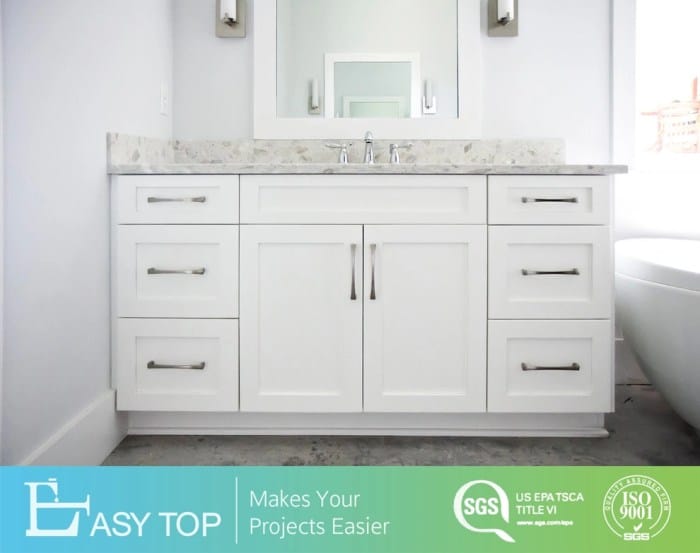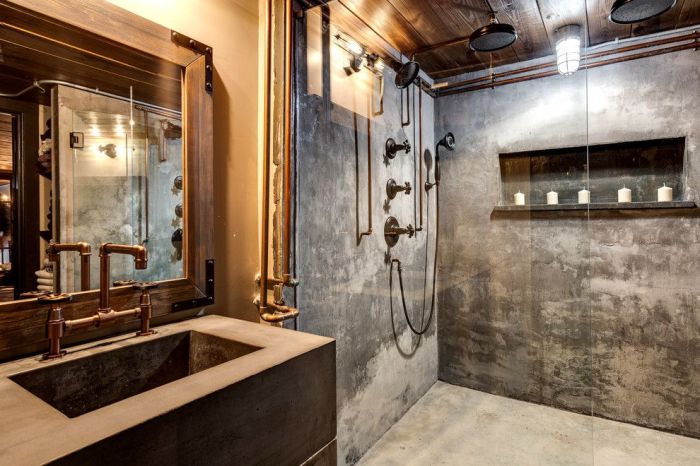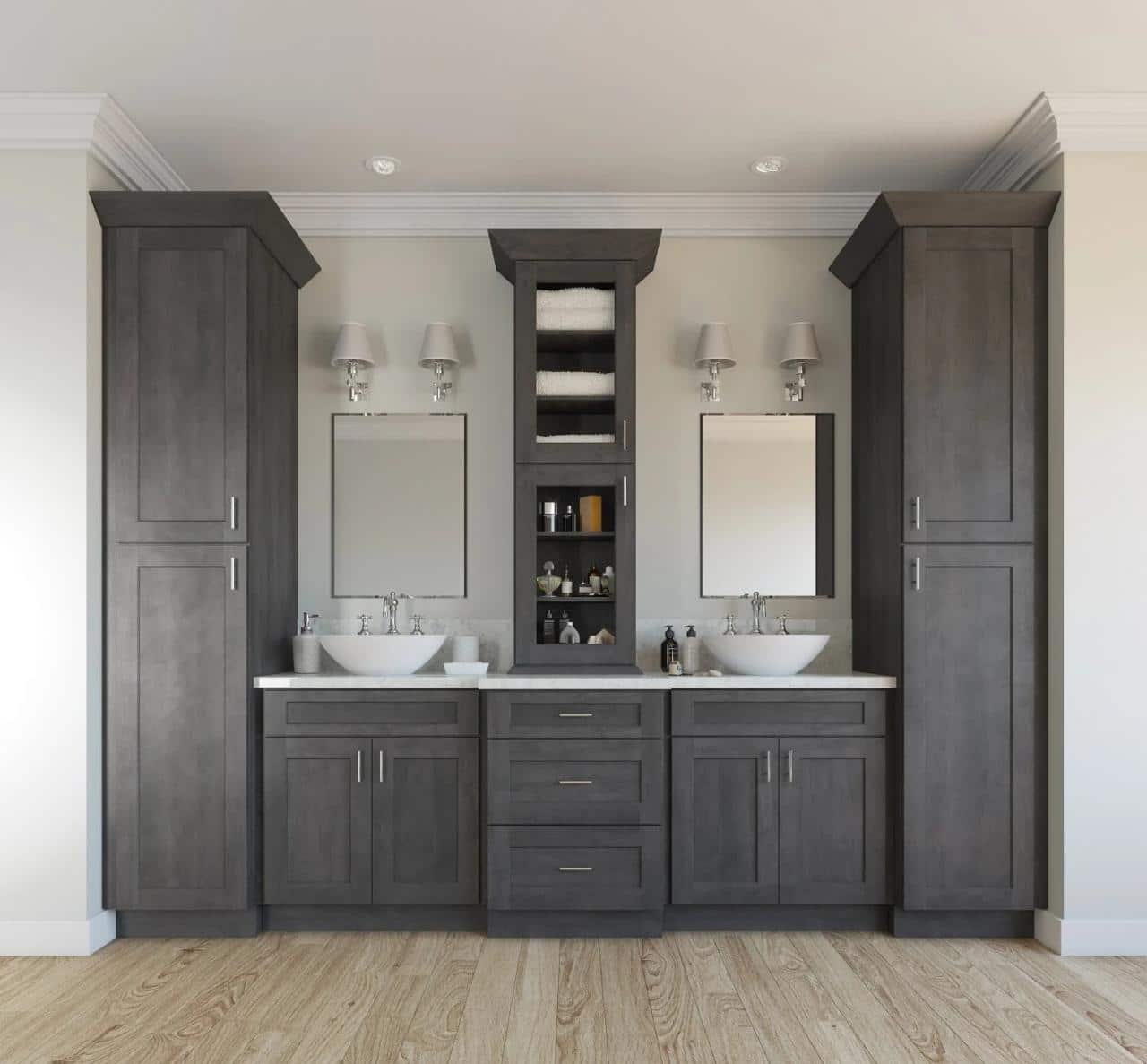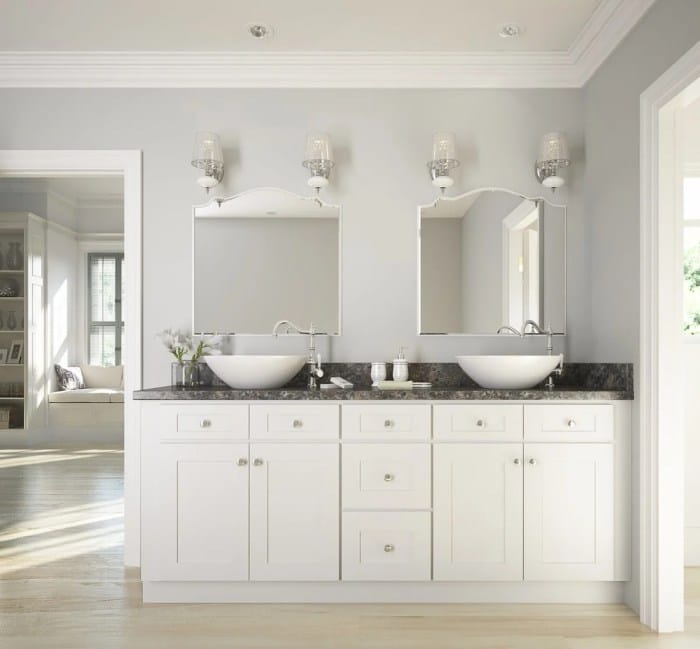Industrial bathroom cabinet ideas transcend mere functionality; they represent a design philosophy. This exploration delves into the captivating world of industrial-style bathroom cabinetry, examining the interplay of materials, finishes, and functionality to create spaces that are both aesthetically striking and highly practical. We will analyze the scientific principles behind material selection, light reflection, and spatial optimization, revealing how these elements contribute to the overall design efficacy.
From the robust allure of reclaimed wood to the sleek minimalism of metal and the raw texture of concrete, each material offers unique properties influencing durability, maintenance, and aesthetic impact. We will dissect the nuances of color palettes, exploring how contrasting shades and finishes manipulate the perception of space and light within the confined environment of a bathroom. The integration of lighting, storage solutions, and distinctive industrial elements will be examined, emphasizing how these components contribute to a cohesive and functional design.
Cabinet Styles for Industrial Bathrooms
The industrial aesthetic, characterized by raw materials, exposed elements, and a utilitarian sensibility, translates beautifully into bathroom design. Choosing the right cabinet style is crucial for achieving a cohesive and functional space. The following explores three distinct cabinet styles, emphasizing material selection, finishes, and hardware choices to enhance the overall industrial feel.
Industrial Cabinet Style: Reclaimed Wood and Metal
This style emphasizes the use of reclaimed wood, showcasing its inherent imperfections and history. The wood, perhaps salvaged from old barns or factories, provides a rich texture and warmth, contrasting beautifully with the cool tones of metal accents. The cabinet structure itself could be constructed from a robust metal frame, perhaps powder-coated in a matte black or deep gray finish, which provides a sturdy base and complements the wood’s natural variations.
The combination of these materials directly reflects the core tenets of industrial design: repurposing and showcasing the inherent beauty of raw materials. The use of reclaimed wood also promotes sustainability, a growing trend in modern design.Suitable hardware for this style includes blackened steel or cast iron pulls and knobs, which further enhances the raw, utilitarian aesthetic. The slightly rough texture of these materials contrasts pleasantly with the smoother surface of the wood, creating a visually interesting dynamic.
Larger cabinets in this style, perhaps spanning an entire wall, can create a statement piece and provide ample storage. Smaller, floating shelves made from the same reclaimed wood can add functionality and visual continuity.
Industrial Cabinet Style: Metal with a Patina Finish
This style focuses solely on metal, leveraging the unique aesthetic qualities of aged or distressed metal finishes. Instead of a smooth, powder-coated finish, the cabinet would be constructed from steel or iron, treated to develop a natural patina. This patina, a result of oxidation or other weathering processes, adds depth and character, telling a visual story of time and wear.
This approach echoes the industrial focus on raw materials and the acceptance of natural aging processes. The color palette might range from deep browns and greens to subtle grays and blues, depending on the type of patina achieved.Hardware choices for this cabinet style should remain consistent with the aged metal aesthetic. Simple, unadorned metal knobs and pulls, perhaps with a slightly worn or antiqued finish, would complement the overall look.
The cabinet itself could be designed with exposed rivets or welds, further reinforcing the industrial theme. A smaller, compact cabinet in this style, perhaps suitable for a corner or a smaller bathroom, would efficiently maximize space while adding a touch of rustic charm.
Industrial Cabinet Style: Concrete and Steel
This style offers a more modern interpretation of industrial design, incorporating the clean lines and robust nature of concrete. The cabinet’s structure could be a combination of polished concrete and brushed steel. The smooth, cool surface of the concrete provides a striking contrast to the warm tones of wood or the aged metal finishes in the previous styles. Steel accents, such as a steel frame or legs, add strength and reinforce the industrial theme.
The use of concrete also brings a sense of solidity and permanence to the bathroom. This material is also exceptionally durable and resistant to moisture, making it a practical choice for a high-humidity environment like a bathroom.The hardware for this style could consist of sleek, minimalist steel pulls and knobs. These should have a brushed or matte finish to avoid clashing with the concrete’s smooth surface.
The overall aesthetic is one of clean lines and understated elegance, a contemporary take on the traditional industrial aesthetic. A large, custom-built vanity with integrated sinks in this style can be a stunning focal point of the bathroom, providing ample storage and a luxurious feel.
Comparison of Industrial Bathroom Cabinet Styles
| Style | Material | Finish | Hardware | Size Options |
|---|---|---|---|---|
| Reclaimed Wood & Metal | Reclaimed wood, metal | Natural wood, matte black/gray powder coat | Blackened steel/cast iron | Large vanities, floating shelves |
| Patina Metal | Steel/iron | Natural patina (brown, green, gray) | Antiqued metal | Small, compact cabinets |
| Concrete & Steel | Polished concrete, brushed steel | Smooth concrete, brushed steel | Sleek steel | Large vanities, custom designs |
Material Choices for Industrial Bathroom Cabinets
The choice of material significantly impacts the aesthetic, durability, and cost of an industrial bathroom cabinet. The raw, utilitarian feel of industrial design lends itself well to certain materials, while others might clash with the overall aesthetic. Understanding the properties of each material is crucial for making an informed decision that aligns with both style and practicality.
Reclaimed Wood Cabinetry
Reclaimed wood, often sourced from old barns, factories, or railway sleepers, brings a unique character to industrial bathroom designs. Its inherent imperfections—knots, cracks, and variations in color—contribute to the rustic charm associated with industrial style. The density of the wood, however, varies greatly depending on the source. Some reclaimed woods, like old-growth pine, are incredibly durable, while others might require additional treatment to withstand the moisture-rich environment of a bathroom.Maintenance for reclaimed wood cabinets involves regular dusting and occasional cleaning with a damp cloth.
Avoid harsh chemicals, as they can damage the wood’s finish. Periodic application of a water-resistant sealant is recommended to protect against moisture damage. The cost of reclaimed wood cabinets can vary significantly depending on the type of wood, its condition, and the level of craftsmanship involved. Generally, expect to pay a premium compared to mass-produced cabinets.
- Aesthetic Contribution: Reclaimed wood imparts a sense of history and authenticity, adding warmth and texture to the typically cool tones of an industrial space. The variations in color and grain create a visually interesting and unique piece.
Metal Cabinetry
Metal, particularly steel and iron, is a quintessential material in industrial design. Its strength, durability, and resistance to moisture make it a practical choice for bathroom cabinets. Powder-coated finishes offer additional protection against corrosion and provide a wide range of color options, allowing for customization to suit different industrial aesthetics. However, metal cabinets can be susceptible to dents and scratches, especially if not properly handled.
Maintenance for metal cabinets typically involves wiping them down with a damp cloth. Powder-coated finishes are generally easy to clean, but avoid abrasive cleaners that could damage the coating. Regular inspections for rust or chipping are advisable, particularly in humid environments. The cost of metal cabinets can range widely depending on the type of metal, the finish, and the complexity of the design.
Steel tends to be more cost-effective than iron, while custom-fabricated metal cabinets will generally be more expensive than mass-produced ones.
- Aesthetic Contribution: Metal cabinets contribute a clean, sleek, and robust aesthetic to an industrial bathroom. Their inherent strength and simple lines reinforce the industrial feel, while powder-coating allows for a pop of color or a more subdued, matte finish.
Concrete Cabinetry
Concrete, a material often associated with raw industrial spaces, offers a striking visual contrast in a bathroom setting. Its inherent strength and durability make it a long-lasting option, capable of withstanding daily wear and tear. However, concrete is porous and requires proper sealing to prevent water damage and staining. Furthermore, the weight of concrete cabinets can present logistical challenges during installation.Maintenance of concrete cabinets involves regular cleaning with a damp cloth and a mild detergent.
Avoid acidic cleaners, as they can etch the concrete’s surface. A high-quality sealant should be applied regularly to maintain its water resistance. The cost of concrete cabinets is generally higher than wood or steel cabinets due to the specialized fabrication process and the materials involved. The labor-intensive nature of creating concrete cabinets also contributes to their higher cost.
- Aesthetic Contribution: Concrete cabinets bring a modern, minimalist aesthetic to an industrial bathroom. Their smooth, monolithic form creates a sense of solidity and permanence, while the subtle variations in color and texture add depth and visual interest. A polished concrete finish can offer a sleek, almost reflective surface, while a more textured finish provides a rougher, more industrial look.
Color Palettes and Finishes for Industrial Bathroom Cabinets
The selection of color palettes and finishes for industrial bathroom cabinets significantly impacts the overall aesthetic and functionality of the space. The interplay of color and texture affects light reflection, perceived size, and the mood of the bathroom, creating a space that is both visually appealing and practical. Understanding the principles of color theory and the properties of different finishes is crucial in achieving the desired industrial aesthetic.
Industrial Color Palettes for Bathroom Cabinets
The industrial style often evokes a sense of raw, utilitarian beauty. To achieve this, three distinct color palettes are particularly effective:
- Palette 1: Monochromatic Metallics: This palette centers around varying shades of gray, from charcoal to pewter, accented with metallics like brushed nickel or copper. The gray provides a neutral backdrop, while the metallics add depth and a touch of industrial shine. This palette is particularly effective in smaller bathrooms, as the neutral tones do not visually shrink the space. Imagine cabinets in a dark charcoal gray with brushed nickel hardware; the subdued tones create a sense of calm and sophistication.
- Palette 2: Rustic Warmth: This palette incorporates warm, earthy tones like deep browns, burnt oranges, and muted yellows, often paired with black accents. The warm tones create a cozy atmosphere, while the black provides a grounding contrast. This palette evokes a sense of history and craftsmanship, characteristic of industrial design’s roots in repurposed materials. Envision cabinets crafted from reclaimed wood in a rich brown, with black metal hardware and a distressed finish; this creates a sense of aged elegance.
- Palette 3: Cool Industrial Contrast: This palette combines cool grays and blues with bold black accents. The cool tones create a clean, modern feel, while the black adds a touch of industrial edge. This palette is particularly suitable for larger bathrooms, where the cool tones can help to create a spacious and airy atmosphere. Picture cabinets painted in a slate blue with black metal framing and handles; this combination offers a striking visual contrast.
Impact of Finishes on Industrial Bathroom Cabinets
The choice of finish significantly alters the perception of the cabinets and the entire bathroom.
- Distressed Finishes: Distressed finishes, often achieved through techniques like sanding or distressing paint, evoke a sense of age and history. This is particularly suitable for industrial designs, which often celebrate the beauty of wear and tear. The visual texture added by a distressed finish can make cabinets appear more substantial and less sterile.
- Polished Finishes: Polished finishes, such as high-gloss lacquers or polished metals, reflect light effectively, making the bathroom appear larger and brighter. However, polished finishes can also highlight imperfections and require more maintenance. They are best suited for modern industrial styles where sleekness is prioritized.
- Matte Finishes: Matte finishes offer a subtle elegance and minimize glare. They are less prone to showing fingerprints and scratches than polished finishes, making them a practical choice for high-traffic areas. Matte finishes work well with both rustic and modern industrial aesthetics.
Effect of Color and Finish on Perceived Size and Light Reflection
Color and finish interact to influence the perceived size and brightness of a bathroom. Darker colors and matte finishes absorb light, making the space feel smaller and cozier. Conversely, lighter colors and polished finishes reflect light, creating a sense of spaciousness and brightness. For example, a small bathroom with dark cabinets and a matte finish might feel cramped, whereas the same bathroom with light-colored, polished cabinets would feel significantly more open and airy.
This principle is rooted in the physics of light absorption and reflection; darker surfaces absorb more light wavelengths, while lighter surfaces reflect more. This effect is amplified by the finish – a glossy surface reflects light more efficiently than a matte surface.
Cabinet Functionality and Storage Solutions

Industrial bathroom design, while aesthetically striking with its raw materials and utilitarian aesthetic, presents unique storage challenges. The open nature often associated with the style, while visually appealing, can lead to clutter if not carefully managed. Furthermore, the desire to maintain the industrial feel can sometimes conflict with the need for practical and efficient storage solutions. Careful consideration of cabinet functionality is crucial to balancing form and function in this design scheme.
Three key storage challenges in industrial-style bathrooms are maximizing limited space, maintaining visual order despite the inherent openness of the style, and accommodating a variety of bathroom items with diverse shapes and sizes. Addressing these requires a strategic approach to cabinet design that integrates both open and closed storage solutions.
Solutions to Industrial Bathroom Storage Challenges
The limited space typical of many bathrooms necessitates efficient storage solutions. Deep, narrow cabinets maximize vertical space, often overlooked in standard bathroom designs. Custom-built units can be tailored to fit awkward corners or alcoves, eliminating wasted space. Furthermore, using multi-functional furniture, such as cabinets with integrated towel racks or mirrored doors, adds storage capacity without visually cluttering the space.
Incorporating Open and Closed Storage
The juxtaposition of open and closed storage is key to a successful industrial bathroom design. Open shelving, often made of reclaimed wood or metal, provides a visually appealing display for frequently used items such as towels, baskets, and decorative elements, reflecting the industrial aesthetic. However, closed storage, such as drawers and cabinets, is essential for concealing less aesthetically pleasing items, toiletries, and cleaning supplies, maintaining a sense of order.
The ratio of open to closed storage should be carefully considered; a balance is crucial to avoid a cluttered look. For instance, a large, closed base cabinet could be paired with a smaller, open shelf above for a visually appealing and practical solution.
Innovative Storage Solutions within Industrial Bathroom Cabinets
Industrial bathroom cabinets can benefit from innovative storage solutions that maximize functionality. Pull-out drawers, particularly those with internal dividers, provide easy access to smaller items, keeping them organized and preventing clutter. Hidden compartments within larger cabinets can be used to store less frequently accessed items, maintaining a clean and uncluttered look. Consider incorporating pull-out spice racks or drawer organizers designed for kitchens; they adapt surprisingly well to bathroom storage needs.
These systems can easily organize small items like cotton balls, makeup brushes, or medications. Furthermore, utilizing vertical space with slim, tall cabinets and adding internal shelving units can significantly increase capacity.
Storage Solutions for Different Bathroom Sizes
| Storage Solution | Small Bathroom (<50 sq ft) | Medium Bathroom (50-75 sq ft) | Large Bathroom (>75 sq ft) |
|---|---|---|---|
| Deep, narrow cabinets | Highly suitable | Suitable | Suitable |
| Floating shelves | Moderately suitable (use sparingly) | Suitable | Highly suitable |
| Corner cabinets | Highly suitable | Suitable | Suitable |
| Wall-mounted cabinets | Suitable | Highly suitable | Highly suitable |
| Pull-out drawers | Highly suitable | Highly suitable | Highly suitable |
| Open shelving | Use sparingly | Moderately suitable | Highly suitable |
Lighting and Cabinet Integration

Effective lighting integration within industrial-style bathroom cabinets is crucial for both functionality and aesthetic appeal. The interplay of light and shadow, carefully considered in relation to the cabinet’s design and materials, significantly impacts the overall bathroom ambiance. Strategic placement of lighting sources enhances the visual impact of the chosen materials, textures, and finishes, creating a cohesive and stylish space.The strategic placement of light sources within and around industrial bathroom cabinets significantly enhances their functionality and aesthetic appeal.
Different lighting technologies offer unique advantages, affecting both the visual warmth and energy efficiency of the space.
Lighting Technologies and their Impact on Ambiance
The choice of lighting technology directly influences the overall ambiance of the industrial bathroom. Incandescent bulbs, while offering a warm, inviting glow, are less energy-efficient than LEDs. LEDs, conversely, offer superior energy efficiency and longevity, and come in various color temperatures, ranging from warm white to cool white, allowing for precise control over the atmosphere. For example, warm white LEDs (around 2700K) create a cozy, relaxing atmosphere ideal for a spa-like bathroom experience, while cooler white LEDs (around 5000K) provide brighter, more task-oriented lighting, suitable for applying makeup or shaving.
The selection should align with the desired mood and functionality of the space.
Industrial Lighting Fixture Styles
Several lighting fixture styles complement the industrial aesthetic. Exposed filament bulbs housed within metal cages or shades, reminiscent of factory lighting, offer a distinctly industrial feel. Linear fluorescent fixtures, often encased in metal housings, provide a more contemporary industrial look, suitable for under-cabinet lighting. Pendant lights with exposed wiring and simple, geometric shapes further enhance the industrial theme.
Recessed lighting, while less overtly industrial, can be integrated seamlessly into the ceiling, providing functional ambient lighting without detracting from the overall design. The key is to select fixtures with simple lines, metallic finishes (such as brushed nickel or matte black), and a sense of ruggedness.
Designing a Functional and Visually Appealing Lighting Scheme
Designing a lighting scheme requires a systematic approach. First, assess the cabinet’s size, layout, and intended use. Consider incorporating under-cabinet lighting for task illumination, such as applying makeup or shaving. Internal lighting within larger cabinets can illuminate stored items, enhancing functionality. Ambient lighting, provided by ceiling fixtures or strategically placed wall sconces, creates a softer, more inviting atmosphere.
The placement of light sources should be carefully planned to avoid harsh shadows and glare. Dimmers offer excellent control over the intensity of lighting, allowing for customization based on the time of day or mood. For example, dimmable LED strip lights under cabinets can provide adjustable task lighting, while a dimmer switch for a central pendant light allows for control over the overall room ambiance.
A well-designed lighting scheme seamlessly integrates with the cabinet’s design, enhancing both its functionality and aesthetic appeal.
Incorporating Industrial Elements into Cabinet Design

The successful integration of industrial elements into bathroom cabinet design hinges on a delicate balance: maintaining the rugged aesthetic while ensuring functionality and visual harmony. This involves a careful selection and application of materials, techniques, and design features that evoke the spirit of industrial spaces without sacrificing practicality or elegance. The key lies in understanding how to blend the raw, often unfinished textures of industrial design with the refined needs of a modern bathroom.
Incorporating industrial elements is not simply about adding metal accents; it’s about understanding the principles of industrial design and applying them thoughtfully. This involves considering the interplay of materials, textures, and colors to create a cohesive and visually appealing space. The goal is to achieve a look that is both stylish and functional, reflecting the raw beauty of industrial aesthetics without compromising the practicality of bathroom cabinetry.
Exposed Piping and Metal Accents
Exposed plumbing, a hallmark of industrial design, can be artfully incorporated into cabinet construction. Instead of concealing pipes, consider routing them visibly along the cabinet’s exterior, perhaps using black iron pipe with contrasting fittings. This can be particularly effective with open shelving units, where the pipes can act as structural supports or even decorative elements. Metal accents, such as brushed steel handles or hinges, further enhance the industrial feel.
These should be chosen to complement, not clash with, the overall color palette and material choices. For example, a cabinet with a reclaimed wood finish might pair well with blackened steel hardware, while a painted metal cabinet could benefit from polished brass accents. The strategic placement of these metal elements adds visual interest and reinforces the industrial aesthetic.
Rivets and Distressed Finishes
Rivets, traditionally used in metalwork, can add a tactile and visual layer of authenticity. They can be used to fasten metal panels on cabinet doors or to create decorative patterns on the cabinet’s surface. The subtle texture and visual weight of rivets contribute to the overall industrial feel. Creating a distressed or aged look requires a more nuanced approach.
Techniques include using sandpaper to create a worn appearance on wood surfaces, applying a layer of white paint and then distressing it to reveal the underlying color, or using chemical washes to achieve an antique effect on metal components. The goal is to simulate the effects of time and wear, creating a sense of history and authenticity. This approach allows for a degree of personalization, enabling homeowners to tailor the level of distressing to their preferences.
Design Features Defining Industrial Style
Several key design features clearly define an industrial style in bathroom cabinetry.
The following list Artikels crucial elements that contribute to the characteristic aesthetic:
- Reclaimed or distressed wood: The use of reclaimed wood, with its inherent imperfections and variations in color and texture, is a cornerstone of industrial design. This adds character and warmth to the overall aesthetic.
- Metal framework and accents: A visible metal framework, perhaps constructed from steel or iron, provides a sturdy and robust base. Metal accents, such as handles, hinges, and decorative elements, further enhance the industrial feel.
- Exposed hardware and mechanics: Rather than concealing hardware and mechanical elements, industrial design often celebrates them. This might involve leaving hinges and fasteners exposed or incorporating visible piping as a design feature.
- Neutral color palettes: Industrial aesthetics typically employ a muted color palette, often featuring shades of gray, black, brown, and white. These colors provide a neutral backdrop that allows the textures and materials to take center stage.
- Clean lines and simple forms: Industrial design is characterized by clean lines, simple forms, and a lack of unnecessary ornamentation. This creates a sense of order and functionality.
Conclusion

Designing an industrial bathroom cabinet is a journey of material science, aesthetic exploration, and functional optimization. By carefully considering the interplay of materials like reclaimed wood, metal, and concrete; the impact of color palettes and finishes on light reflection and spatial perception; and the strategic integration of lighting and storage solutions, one can craft a truly unique and functional space.
The principles discussed here—from selecting durable and aesthetically pleasing materials to optimizing storage and lighting—provide a foundation for creating an industrial bathroom that is both visually stunning and practically efficient. The resulting design transcends mere aesthetics, becoming a testament to thoughtful design and the harmonious blend of form and function.
Commonly Asked Questions
What are some common mistakes to avoid when designing industrial bathroom cabinets?
Overlooking ventilation (especially with wood cabinets to prevent moisture damage), neglecting proper sealing against water ingress, and using hardware that clashes with the overall industrial aesthetic are common pitfalls. Insufficient lighting can also detract from the design’s impact.
How can I incorporate sustainable practices into my industrial bathroom cabinet design?
Prioritize reclaimed or sustainably sourced wood. Opt for low-VOC (volatile organic compound) paints and finishes. Consider using recycled metals. Efficient LED lighting minimizes energy consumption.
What is the average lifespan of an industrial-style bathroom cabinet?
Lifespan varies greatly depending on the materials used and maintenance. Well-maintained metal cabinets can last for decades, while reclaimed wood cabinets might require more frequent refinishing. Proper sealing and ventilation are crucial for longevity.
Are industrial bathroom cabinets suitable for small bathrooms?
Yes, but careful planning is crucial. Strategically placed mirrors, light colors, and efficient storage solutions can maximize the feeling of space. Smaller, streamlined cabinets are ideal for smaller bathrooms.